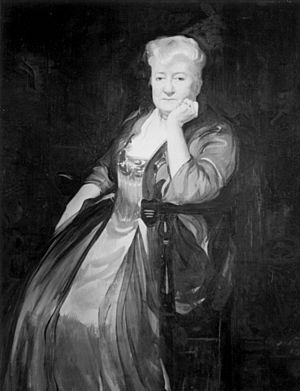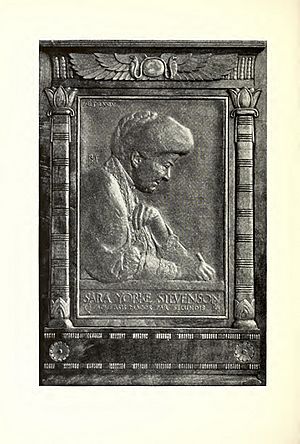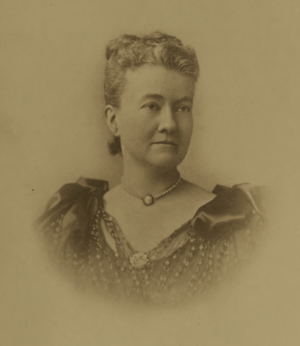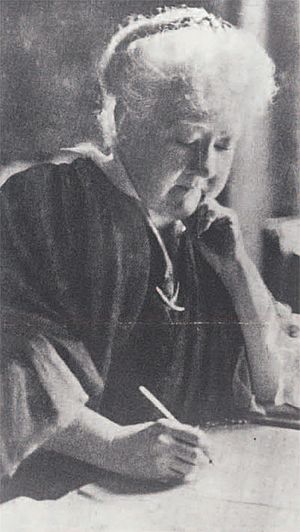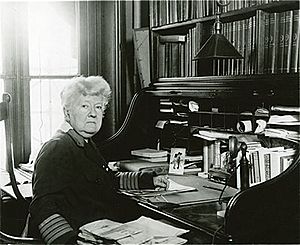Sara Yorke Stevenson facts for kids
Sara Yorke Stevenson (born February 19, 1847 – died November 14, 1921) was an amazing American woman. She was an archaeologist who studied ancient Egypt (this is called Egyptology). She helped start the Penn Museum. Sara was also a strong supporter of women's right to vote and a women's rights activist. She even wrote for a newspaper called the Philadelphia Public Ledger.
As a scholar, Sara wrote books and articles about Egyptology and ancient cultures from the Near East. She also wrote a book about her experiences during the time of Maximilian I of Mexico in Mexico. She was the first person to be in charge of the Egyptian Collection at the Penn Museum. She helped get many important items for the museum's collection. As a women's rights activist, she was the first president of the Equal Franchise Society. She also led the Civic Club of Philadelphia. Sara was the first woman to get an honorary degree from the University of Pennsylvania. She was also the first woman to give a lecture at the Peabody Museum of Archaeology and Ethnology at Harvard University. Plus, she was the first woman to be a judge for the Ethnology awards at the World's Columbian Exposition in Chicago.
Contents
Early Life of Sara Yorke Stevenson
Childhood and Family
Sara Yorke Stevenson's parents were Edward Yorke and Sarah Hanna Yorke. They got married in New Orleans, Louisiana, in 1834. In the 1840s, they moved to Paris, France. Both of her parents came from well-known families. Her mother's family owned a large cotton plantation. Her father was a cotton broker, which means he bought and sold cotton.
Edward Yorke was born in Philadelphia. He moved to New Orleans for his law firm. In Louisiana, he helped set up the public school system in New Orleans. He also became interested in business, like bringing gas to Paris. He also worked on a railway project in Tehuantepec, Mexico. He passed away in Vermont in 1868. Sarah Hanna was born in Alabama. She moved with her family to New Orleans.
Sara was the youngest of five children. Her older siblings were Edward, Ellen, Ogden, and Mary.
Growing Up in France
Sara Letitia Yorke was born in Paris, France, on February 19, 1847. When she was ten, her parents moved back to the United States. They left Sara and her sisters to attend boarding school in France. Sara lived in Paris from 1858 to 1862. During this time, she was cared for by a guardian. This person sparked Sara's early interest in archaeology and Egyptology. She also met the Duke of Morny. He was a powerful figure in the French Intervention in Mexico. Sara would soon learn a lot about this conflict. In 1862, Sara left France to travel to Mexico by ship. She wrote about her journey:
There were only forty passengers on board. There was not much excitement before the ship left. I easily found the French banker and his Mexican wife. They had kindly agreed to look after me on my lonely trip. I soon found out that she and I were the only women passengers on board.
Life in Mexico
In 1862, the Yorke family moved to Tacubaya. This was a suburb of Mexico City. In Mexico, Sara went to many social events. She met the new Empress of Mexico, Charlotte of Belgium, and her husband, Maximilian. Sara wrote a book called Maximilian in Mexico: A Woman's Reminiscences of the French Intervention 1862-1867. This book gave a great look into what court life was like during that time.
Moving to the United States
In 1867, the Yorke family moved to Vermont. Sara's father died just one year later, in 1868. Soon after, at age twenty-one, Sara Yorke moved to Philadelphia. She lived with two of her uncles and an aunt from her father's side of the family.
Marriage and Family Life
Sara Yorke married Cornelius Stevenson on June 30, 1870. Cornelius was a lawyer from Philadelphia. He was born in Philadelphia on January 14, 1842. He was the only son of Adam May and Anna Smith (Philips) Stevenson. He served in the army during the American Civil War.
Sara Yorke Stevenson and Cornelius Stevenson had one child. His name was William Yorke Stevenson (1878-1922). He later married Christine Wetherill Rice.
Sara's Passing
Sara Yorke Stevenson passed away on November 14, 1921. In February 1922, the Pennsylvania Museum Bulletin honored her. They described her as a "dignified little figure" who always had the right advice. They said her wisdom came from half a century of knowing brilliant people. Her experiences in Mexico, Paris, and Egypt made her advice special. She was known for being understanding and tolerant.
Her writings and papers were later given to La Salle University's Connelly Library. She is buried at the Laurel Hill Cemetery in Philadelphia.
Sara's Professional and Community Work
Leading Community Groups
Stevenson was a leader in many local community groups. She helped start and was the first president of the Equal Franchise Society of Philadelphia. This group worked for women's right to vote. She also co-founded and was president of the Civic Club of Philadelphia. This was a group of women who worked to improve their community. She led the Acorn Club for 25 years and was president of the Contemporary Club. She also chaired the French War Relief Committee.
She was part of the Women's Centennial Committee for the Philadelphia Centennial Exhibition in 1876. This committee created the "Women's Building." It was the first time an international event showed the achievements of women. It was a big step for the women's movement in the 1800s.
The Furness-Mitchell Coterie
Sara was part of a special group of scholars in Philadelphia. They were known as the Furness-Mitchell Coterie. This group included musicians, doctors, writers, and educators. They were important in the fields of anthropology and other areas in the late 1800s and early 1900s. This group was special because it welcomed talented women as equals. Because she was part of this group, Sara worked closely with other members. These included Horace Howard Furness, Owen Wister, and S. Weir Mitchell.
Fighting for the Right to Vote
Stevenson started the Equal Franchise Society of Pennsylvania. She recognized how hard it was for women to get the right to vote. She was president until 1910. Then she was the first vice president until women gained the right to vote in 1920. In 1910, her society republished a speech called "Shall Women Have the Right to Vote?". Sara wrote a special introduction for it. She wrote about the long fight for women's suffrage.
She believed that people who didn't support women's right to vote needed to be educated. She said, "What we need to do today is not to fight men and groups who don't think like us… but to teach them, help them to see, to know, to love, to feel, to grow."
Sara's Career and Achievements
Studying Ancient Cultures
In the 1880s, anthropology was a new field of study. Universities were just starting to create departments for it. Sara became involved in studying ancient Egypt through the American branch of the Egypt Exploration Fund. This group was started in 1882 by Amelia Edwards. Sara traveled overseas many times during her career. However, she never led her own archaeological digs.
She helped build the collections of what is now the University of Pennsylvania's Museum of Anthropology and Archaeology. She was the first curator for the Egyptian and Mediterranean section. She got this job in 1890. An article in Popular Science Monthly in 1892 said that Sara "is perhaps [America's] only lady Egyptologist. Her lectures on Egyptian topics have caused a sensation." She learned from important scholars like Frederick Ward Putnam and Franz Boas. Sara was interested in many topics. These included how cultures spread and how they changed over time.
In 1892, Sara was chosen to be a judge for the Ethnology awards. This was at the World's Columbian Exposition in Chicago. A special law had to be passed to allow a woman to serve in this role. Sara was even elected vice president of the jury. In 1894, she was the first woman to speak at the Peabody Museum of Archaeology and Ethnology. Her talk was about "Egypt at the Dawn of History." She was also president of the Oriental Club of Philadelphia. She was a founder and officer of several other important groups. In 1895, she was one of the first two women allowed into the American Philosophical Society.
In 1894, Sara Stevenson was the first woman to receive an honorary doctorate degree from the University of Pennsylvania. She also received an honorary degree from Temple University.
Langdon Warner said about Sara: "If women today find it easy to be recognized as scholars, and if their advice is wanted in Museums, it is thanks to Mrs. Stevenson much more than our generation will ever know."
Helping to Build the Penn Museum
Stevenson played a key role in starting the University of Pennsylvania Museum of Archaeology and Anthropology (known as the Penn Museum). In 1891, Sara and others were asked to create the Department of Archaeology and Paleontology. Sara then served on the museum's governing board from 1892 to 1905. She helped build the "Free Museum of Science and Art." This museum opened in 1899 and later became the Penn Museum.
She was the curator of the Egyptian and Mediterranean section from 1890 to 1905. As curator, Sara focused on getting new items for the collections. In 1898, she traveled to Egypt. She bought 42 cases of artifacts for the American Exploration Society. Most of these came from the ancient site of Dendereh. This included the Penn Museum's first papyrus.
In 1905, Sara and over 125 supporters left their positions at the museum. This happened because of a disagreement involving Hermann Volrath Hilprecht. Even though Hilprecht was cleared of any wrongdoing, Sara never returned to her job at the museum.
Her biography at the Penn Museum states: "As one of the main founders of the University Museum, whose help in building the Museum was vital to its success, Stevenson set a strong example for generations of women to follow."
Writing for Newspapers
Stevenson wrote as a columnist for the Philadelphia Public Ledger newspaper. She used the pen names Peggy Shippen ("Peggy Shippen's Diary") and Sally Wistar ("Sally Wistar Says") until 1920. As Peggy Shippen, she wrote a social column for important people in Philadelphia. Her pen name honored Peggy Shippen, a famous woman from Philadelphia during the American Revolutionary War.
Teaching Museum Studies
After leaving the Penn Museum in 1905, Sara created one of the first college courses in the United States to train museum professionals. She taught this course at the Pennsylvania Museum and School of Industrial Art. This school is now known as The University of the Arts (Philadelphia). Her lectures covered topics like "The Modern Museum and its Functions" and "The Diseases of Objects and Remedies." She also became a curator at the museum now known as the Philadelphia Museum of Art.
Images for kids


